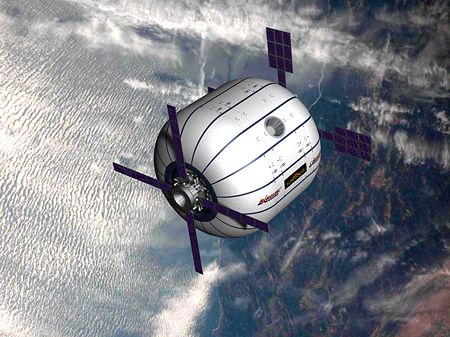- Sundancer
Infobox Space station
station = Sundancer
station_
station_image_caption = Concept art of the "Sundancer" module
sign =
crew = 3 (1)
launch = 2009-2010 (1)
launch_pad =
reentry =
status = Proposed
mass = 8,618.4 kg
(19,000.3 lb) (1)
length = 8.7 m (28.5 ft) (2)
diameter = 6.3 m (20.6 ft) (2)
volume = 180 m³ (6,357 ft³) (1)
pressure =
perigee =
apogee =
inclination = 40.0 degrees (1)
altitude = 463 km (288 mi) (1)
speed =
period =
orbits_day =
in_orbit =
occupied =
orbits =
distance =
stats_ref = 1cite web |url=http://www.space.com/news/060921_bigelow_plans.html |title=Private Space Habitat Could Launch by 2010 |work=Space.com |first=Warren |last=Ferster |date=2006-09-21 |accessdate=2007-07-28] , 2cite web |url=http://www.aviationweek.com/aw/generic/story_generic.jsp?channel=awst&id=news/aw040907p2.xml |title=Bigelow Reveals Business Plan |work=Aviation Week |first=Craig |last=Covault |date=2007-04-08 |accessdate=2007-07-28]"Sundancer" is the proposed third prototype
space habitat to be launched byBigelow Aerospace and the first human-rated inflatable module based on theTranshab design byNASA . It will be used to test and confirm systems used in the company's commercial space station efforts, and if successful, will form the first piece of the proposed commercial space station.pacecraft history and future
Upon its original announcement, "Sundancer" was intended to be the fourth module orbited by Bigelow Aerospace. In August 2007, however, it was announced that due to rising space launch costs and the level of success in previous modules, the "Galaxy" spacecraft would not be launched and "Sundancer"
' s program would be accelerated. The life support and other advanced systems intended for launch on "Galaxy", and potentially the spacecraft itself, would still be built and used for ground testing.cite news |url=http://www.bigelowaerospace.com/news/?Special_Announcement |title=Special Announcement |work=BigelowAerospace.com |first=Robert |last=Bigelow |date=2007-08-13 |accessdate=2007-12-20]Currently scheduled for a launch by 2009 or 2010 aboard a yet-to-be-determined launch vehicle, "Sundancer" will spend its first six to nine months on-orbit in a checkout configuration to test systems, followed by manned shakedown missions when transport vehicles become available. If these manned missions prove successful, Bigelow plans to use "Sundancer" as the starting point of the first commercial space complex. The company intends to launch a combined propulsion bus and central node to the module in 2011, followed by a full-size "
BA 330 " module in both 2012 and 2013. The two "BA 330" modules would dock with the central node, which previously connected to "Sundancer", and the first of several planned commercial space stations would begin operation. A one-week trip to the complex is currently estimated to be priced at US$7.9 million.cite web |url=http://www.popsci.com/scitech/article/2005-03/five-billion-star-hotel?page=3 |title=The Five-Billion-Star Hotel |work=Popular Science |first=Michael |last=Belfiore |month=March |year=2005 |accessdate=2007-08-03]ystems and configuration
"Sundancer" will be equipped with full life support systems, attitude control , orbital maneuvering systems, and will be capable of reboost and deorbit burns. Like the "Genesis" pathfinders, "Sundancer" will launch with its outer surface compacted around its central core, with air expanding it to its full size after entering orbit. After expansion, the module will measure 8.7 m (28.5 ft) in length and 6.3 m (20.6 ft) in diameter, with 180 cubic meters (greater than 6,000 cubic feet) of interior volume. Unlike previous Bigelow craft, it will feature three observation windows.
"Sundancer"
' s propulsion system will initially be used to boost the module into a high orbit for long duration testing and will later lower it back into an orbit reachable by manned spacecraft. It will be equipped with a Soyuz-type docking system on one end of the craft and a NASA-developedLow Impact Docking System on the other.Bigelow has a contract with
Aerojet for the "Sundancer" aft propulsion system, which will provide a three-axisattitude control system and propulsion for a de-orbit maneuver.Andrews Space will provide Aerojet with electronic controllers for the aft propulsion system. [cite web |url=http://www.andrews-space.com/news.php?subsection=MzEy |title=Andrews Awarded Aerojet Contract to Build Hardware for Sundancer |date=August 19, 2008 |publisher=Andrews Space ]Bigelow Aerospace is also considering an option to include lights on the exterior of the spacecraft, potentially visible from Earth, which would be a furtherance of the projection system currently flying aboard "Genesis II". Robert Bigelow noted in an interview that "if you have some blue and green and amber-colored lighting going on, you would have something that really has a lot of blink to it."cite news |url=http://cosmiclog.msnbc.msn.com/archive/2007/08/03/303924.aspx |title=Orbital Billboard Lights Up |work=MSNBC Cosmic Log |first=Alan |last=Boyle |date=
2007-08-03 |accessdate=2007-08-10]Launch vehicle
Due to the added size and mass of "Sundancer" over previous modules, the craft will require a medium launch vehicle to take it into orbit. Bigelow is considering several vehicles, including the
SpaceX Falcon 9 , the Ukrainian Yuzhnoye Zenit, and theLockheed Martin Atlas V . Bigelow has also entered discussion with Lockheed regarding the possible use of the Atlas V as a launch vehicle for manned space capsules, which would be required to deliver crew, tourists and material to the new habitat. The problem being faced, however, is that no commercial spacecraft yet exists to deliver humans into orbit, effectively leaving "Sundancer" as "a destination waiting for a means to get there."References
See also
*
Genesis I
*Genesis II
Wikimedia Foundation. 2010.
